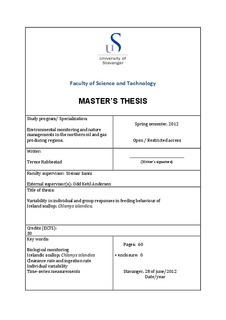| dc.contributor.author | Habbestad, Terese | |
| dc.date.accessioned | 2012-09-18T14:11:55Z | |
| dc.date.available | 2012-09-18T14:11:55Z | |
| dc.date.issued | 2012 | |
| dc.identifier.uri | http://hdl.handle.net/11250/182545 | |
| dc.description | Master's thesis in Environmental technology | no_NO |
| dc.description.abstract | Due to regulatory requirements of monitoring the marine environment, and the development of offshore petroleum activities in new and more remote locations, there is at present an emphasis on implementing biological responses in monitoring systems to reflect the environmental conditions over a period of time. Choosing Darwinian fitness parameters that reflect the health status of individuals, such as growth and reproductive potential is highly interesting.
The current study used clearance rate and ingestion rate as parameters to illustrate the feeding behaviour of individual Chlamys islandica, which may be used in estimations of energy turnover (availability of energy to growth and reproduction). A laboratory feeding experiment was set up and the parameters were studied over the course of 12 days. The change in the environmental conditions, from water with low particle concentration to water with medium particle concentration, was reflected in the filtration rates of the individuals. Large fluctuations in the feeding behaviour within and between individual C. islandica were detected in each treatment. Maximum clearance rates varied from 4.20 l/h to 16.50 l/h within a single individual and average clearance rate varied between 2.31 l/h and 10.33 l/h between individuals. Average clearance rate and standard deviation of groups with different size, converged towards the population mean (n=40) with increasing number of individuals in the group. Based on the standard deviation and coefficient of variation, the results indicate that a group of 15-20 scallops give reasonable estimates that can be representative for larger populations.
All of the individuals changed their feeding behaviour from one treatment to another, and more than 87% increased their clearance rates when exposed to water with low particle concentration. This is a good indication that individual responses can be utilised as biosensor units that compare present responses to responses back in time. An individual scallop with high/low clearance rate (compared to the average) in one treatment did not necessarily show the same pattern of high/low clearance in the other treatment. A natural next step to investigate this further will be to continue the experiment with more time-series measurements for each individual, and include treatments with higher particle concentration. | no_NO |
| dc.language.iso | eng | no_NO |
| dc.publisher | University of Stavanger, Norway | no_NO |
| dc.relation.ispartofseries | Masteroppgave/UIS-TN-IMN/2012; | |
| dc.subject | environmental technology | no_NO |
| dc.subject | biological monitoring | no_NO |
| dc.subject | Icelandic scallop | no_NO |
| dc.subject | Chlamys islandica | no_NO |
| dc.subject | ingestion rate | no_NO |
| dc.subject | clearance rate | no_NO |
| dc.subject | individual variability | no_NO |
| dc.subject | time-series measurements | no_NO |
| dc.title | Variability in individual and group responses in feeding behaviour of iceland scallop; chlamys islandica. | no_NO |
| dc.type | Master thesis | no_NO |
| dc.subject.nsi | VDP::Mathematics and natural science: 400 | no_NO |
